Abstract
In contrast to previous censuses, Census 2000 permitted individuals to mark more than one race. Because the new race tables include both single-race and mixed-race categories, measuring change during the 1990s requires some method of bridging between the two data sets.
To accomplish this bridging, we first identified biracial populations as of 1990 through the race and ancestry responses of individuals in the PUMS file. With race responses assumed to represent a person's primary race identity, we then determined the percentage of each biracial group that preferred each race as the primary identity. The same percentages can be used to assign biracial persons from Census 2000 into single-race categories. We also provide fractional assignment percentages for selected states and for the larger specific nationality groups of mixed-race Asians.
Comparison of our 1990 estimates of the numbers in leading biracial groups with those reported in Census 2000 suggests that our fractional assignment values are reasonable for biracial groups other than those involving American Indians and Alaska Natives. For the latter biracial groups and for all groups representing three or more races, we recommend equal fractional assignment into the appropriate single-race categories.
Similar content being viewed by others
References
Allen, J. P.& Turner, E. J. (1988), We the people: An atlas of America's ethnic diversity. New York: Macmillan.
Bennett, C. E., McKenney, N. R.& Harrison, R. J. (1995), Racial classification issues concerning children in mixed-race households. Paper presented at the Annual Meeting of the Population Association of America, San Francisco, April.
Eschbach, K., Supple, K.& Snipp, C. M. (1998), Changes in racial identification and the educational attainment of American Indians, 1970-1990, Demography 35: 35–43.
Field, L. (1996), Piecing together the puzzle: Self-concept and group identity in biracial Black/White youth, pp. 211–226, in M. P. P. Root (ed.), The multiracial experience: Racial borders as the new frontier. Thousand Oaks, CA: Sage Publications.
Goldstein, J. R.& Morning, A. J. (2001), Back in the box: The dilemma of using multiplerace data for single-race laws. Revision of paper presented at conference onMultiraciality, Bard College, September 2000. Available at http://opr.princeton.edu/zjosh/
Harris, D. R.& Sim, J. (2000), An empirical look at the social construction of race: The case of multiracial adolescents.Research ReportNo.00-452,Population Studies Center, University of Michigan. Available at http://www.psc.isr.umich.edu/pubs
Kalmijn, M. (1993), Trends in black/white intermarriage, Social Forces 72: 119–146.
Lee, S. M. (2001), Using the new racial categories in the 2000 census. Washington: The Annie E. Casey Foundation and The Population Reference Bureau.
Nash, G. B. (1995), The hidden history of Mestizo America, Journal of American History 82: 941–962.
O'Hearn, C. C. (ed.) (1998), Half and half: Writers on growing up biracial and bicultural. New York: Pantheon Books.
Passel, J. S. (1996), The growing American Indian population, 1960-1990: Beyond demography, pp. 79–102, in G. Sandefur et al. (eds.), Changing numbers, changing needs: American Indian demography and public health. Washington: National Academy Press.
Perlmann, J. (1997), Reflecting the changing face of America: Multiracials, racial classi-fication, and American intermarriage. Public Policy Brief No. 35, The Jerome Levy Economics Institute of Bard College.
Qian, Z. (1997), Breaking the racial barriers: Variations in interracial marriage between 1980 and 1990, Demography 34: 263–276.
Root, M. P. A. (ed.) (1996), The multiracial experience: Racial borders as the new frontier. Thousand Oaks, CA: Sage Publications.
Root, M. P. P. (ed.) (1992), Racially mixed people in America. Newbury Park, CA: Sage Publications.
Sandefur, G.& McKinnell, T. (1986), American Indian intermarriage,Social Science Research 15: 347–371.
U.S. Census Bureau. 1993. 1990 census of population, social and economic characteristics, United States (CP-2-1), Washington: U.S. Government Printing Office.
U.S. Census Bureau. (1999), Interracial married couples: 1960 to present, Internet web site, MS-3 (January 1999)
U.S. Census Bureau. (2001), Overview of race and Hispanic origin: Census 2000 brief.CENBR/01-1. March. Available at the web site http://www.census.gov/prod/2001pubs/cenbr01-01.pdf
U.S. Office of Management and Budget. (1997), Revisions to the standards for the classification of federal data on race and ethnicity, Announcement, October 30.
U.S. Office of Management and Budget. (2000a), Guidance on aggregation and allocation of data on race for use in civil rights monitoring and enforcement. Bulletin No.00-02. March 9. Available at www.whitehouse.gov/omb/bulletins/b00-02.html
U.S. Office of Management and Budget. (2000b), Provisional guidance on the implementation of the 1997 standards for federal data on race and ethnicity, Executive Office of the President, December 15. Available at the web site www.whitehouse.gov/omb/inforeg/statpol.html
Waters, M. C. (1998), Multiple ethnic identity choices, pp. 47–62, in W. F. Katkin et al. (eds.), Beyond pluralism: The conception of groups and group identities in America. Urbana: University of Illinois Press.
Williams-Leon, T.& Nakashima, C. L. (2001), The sum of our parts: Mixed-heritage Asian Americans. Philadelphia: Temple University Press.
Xie, Y.& Goyette, K. (1997), The racial identification of biracial children with one Asian parent: Evidence from the 1990 census. Social Forces 76(2): 547–570.
Author information
Authors and Affiliations
Rights and permissions
About this article
Cite this article
Allen, J.P., Turner, E. Bridging 1990 and 2000 census race data: Fractional assignment of multiracial populations. Population Research and Policy Review 20, 513–533 (2001). https://doi.org/10.1023/A:1015666321798
Issue Date:
DOI: https://doi.org/10.1023/A:1015666321798




